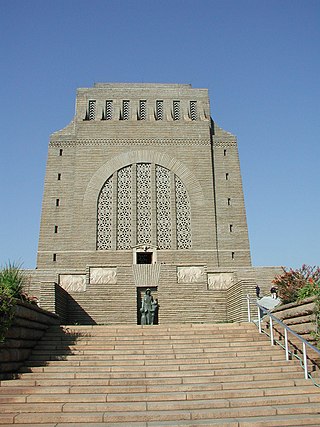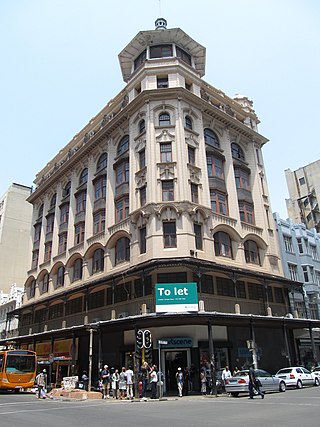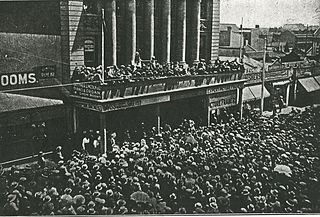Related Research Articles

The Voortrekker Monument is located just south of Pretoria in South Africa. The granite structure is located on a hilltop, and was raised to commemorate the Voortrekkers who left the Cape Colony between 1835 and 1854. It was designed by the architect Gerard Moerdijk.

Bronkhorstspruit is a town 50 km east of Pretoria, Gauteng, South Africa along the N4 highway towards Witbank. It also includes three townships called Zithobeni, Rethabiseng and Ekangala. On 18 May 2011, the Tshwane Metropolitan Municipality took over the municipal administration from the abolished Kungwini Local Municipality, which makes Bronkhorstspruit part of Tshwane.
The Schlesinger Building, also known as Wesbank Centre or Sanlam Centre, is a skyscraper in Braamfontein, Johannesburg, South Africa. It was built in 1965 to a height of 110 metres (360 ft). It has 21 floors. The building is named for John Schlesinger, a Johannesburg businessman who was also one of the first major art collectors in the city.

Jeppestown is a suburb of Johannesburg, South Africa. It is located in Region F of the City of Johannesburg Metropolitan Municipality.

Lixus is an ancient city founded by Phoenicians before the city of Carthage. Its distinguishing feature is that it was continuously occupied from antiquity to the Islamic Era, and has ruins dating to the Phoenician, Punic, Mauretanian, Roman and Islamic periods.

Djémila, formerly Cuicul, is a small mountain village in Algeria, near the northern coast east of Algiers, where some of the best preserved Roman ruins in North Africa are found. It is situated in the region bordering the Constantinois and Petite Kabylie.

The Johannesburg South Africa Temple is the 36th operating temple of the Church of Jesus Christ of Latter-day Saints.

The Huguenot Memorial Building, located at 48 Queen Victoria Street, Cape Town, is a provincial heritage site in Cape Town in the Western Cape province of South Africa.

The Narainsamy Temple is a provincial heritage site in Inanda in the KwaZulu-Natal province of South Africa. It was founded by Narainsamy in 1896, and is now controlled by a family trust that he created. Most of the congregation are Tamil Hindus.
The Shri Jagannath Puri Temple is a provincial heritage site in Inanda in the KwaZulu-Natal province of South Africa.

The Zamani Project is part of the African Cultural Heritage Sites and Landscapes Database. Zamani is a research group at the University of Cape Town, which acquires, models, presents and manages spatial and other data from cultural heritage sites. The present focus of the Zamani project is Africa, with the principal objective of developing “The African Cultural Heritage Sites and Landscapes Database”. Zamani comes from the Swahili phrase “Hapo zamani za kale” which means “Once upon a time”, and can be used to mean 'the past'. The word is derived from Arabic root for temporal vocabulary, ‘Zaman,’ and appears in several languages around the world.
Chennai, with historically rich records dating at least from the time of the Pallavas, houses 2,467 heritage buildings within its metropolitan area (CMA), the highest within any metropolitan area limit in India. Most of these buildings are around 200 years old and older. Chennai is home to the second largest collection of heritage buildings in the country, after Kolkata. The official list of heritage buildings was compiled by the Justice E. Padmanabhan committee. The Tamil Nadu Assembly passed the Heritage Commission Act in 2012 to preserve old heritage structures.

Musawwarat es-Sufra, also known as Al-Musawarat Al-Sufra, is a large Meroitic temple complex in modern Sudan, dating back to the early Meroitic period of the 3rd century BC. It is located in a large basin surrounded by low sandstone hills in the western Butana, 180 km northeast of Khartoum, 20 km north of Naqa and approximately 25 km south-east of the Nile. With Meroë and Naqa it is known as the Island of Meroe, and was listed as a UNESCO World Heritage Site in 2011. Constructed in sandstone, the main features of the site include the Great Enclosure, the Lion Temple of Apedemak and the Great Reservoir. Most significant is the number of representations of elephants, suggesting that this animal played an important role at Musawwarat es-Sufra.

The Houses of Parliament of South Africa are situated in Cape Town. The building consists of three main sections: the original building, completed in 1884, and additions constructed in the 1920s and 1980s. The newer additions house the National Assembly, and the original building houses the National Council of Provinces.

The Cuthberts Building is a Victorian style building found in the city of Johannesburg. The building was designed by architects Stucke & Bannister. Construction of the building began in 1903 and completed in 1904. It rapidly became a major landmark in the mining town and was declared a National Monument on 27 June 1986.

The Trades Hall is one of the oldest Edwardian buildings in the city of Johannesburg. Beyond its architectural importance, the building has historical significance as the previous headquarters of the Trade Unions. It is associated with many historical events such as the 1922 Rand Revolt. In 1986 it was listed as one of Johannesburg's 100 most important heritage buildings.
St. Mary's Anglican Church, a church in the Diocese of Christ the King, built at the beginning of the twentieth century, but before 1907, is one of the first churches built in Rosettenville, Johannesburg. The church was built with a quarried natural stone which was provided by Leo Rosettenstein, the township owner after whom Rosettenville was named. The building was designed by the firm of Baker and Fleming. The churchwardens continue to take good care of the building and it remains in pristine condition.

The Empire Exhibition, South Africa, held in Johannesburg, was intended to mark that city's jubilee and was opened by the Governor-General of the Union of South Africa on 15 September 1936. It was the first exhibition held in the Union of South Africa following two earlier exhibitions in Cape Colony in 1877 and 1892. The idea of an empire exhibition in South Africa was first discussed in 1934 by the Buy Empire Committee of Johannesburg. On 9 January 1935, the Grand Council of the Federation of British Industries passed a resolution for a proposal to hold an Empire Exhibition in Johannesburg in 1936 in conjunction with the Golden Jubilee of the city.

The El Rahman mosque in Cherchell, wilaya of Tipaza Algeria is a 'Roman' mosque.
Temple Israel is the oldest of eleven Progressive synagogues in South Africa. It is a provincial heritage site, built in the Art Deco style by architect Hermann Kallenbach. It is located in the Johannesburg suburb of Hillbrow. It is an affiliate of the South African Union for Progressive Judaism (SAUPJ), which is part of the World Union for Progressive Judaism (WUPJ).
References
- South African Heritage Resource Agency database Archived 31 December 2008 at the Wayback Machine
- |Kzn specially protected heritage resources schedule file.

